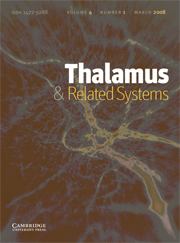Crossref Citations
This article has been cited by the following publications. This list is generated based on data provided by
Crossref.
Montes, Carmen
Magnin, Michel
Maarrawi, Joseph
Frot, Maud
Convers, Philippe
Mauguière, François
and
Garcia-Larrea, Luis
2005.
Thalamic thermo-algesic transmission: ventral posterior (VP) complex versus VMpo in the light of a thalamic infarct with central pain.
Pain,
Vol. 113,
Issue. 1,
p.
223.
Stern, Jair
Jeanmonod, Daniel
and
Sarnthein, Johannes
2006.
Persistent EEG overactivation in the cortical pain matrix of neurogenic pain patients.
NeuroImage,
Vol. 31,
Issue. 2,
p.
721.
Martin, Ernst
Jeanmonod, Daniel
Morel, Anne
Zadicario, Eyal
and
Werner, Beat
2009.
High‐intensity focused ultrasound for noninvasive functional neurosurgery.
Annals of Neurology,
Vol. 66,
Issue. 6,
p.
858.
Walton, K. D.
Dubois, M.
and
Llinás, R. R.
2010.
Abnormal thalamocortical activity in patients with Complex Regional Pain Syndrome (CRPS) Type I.
Pain,
Vol. 150,
Issue. 1,
p.
41.
Henning Proske, J.
Jeanmonod, Daniel
and
Verschure, Paul F. M. J.
2011.
A computational model of thalamocortical dysrhythmia.
European Journal of Neuroscience,
Vol. 33,
Issue. 7,
p.
1281.
Pirrotta, Roberto
Jeanmonod, Daniel
McAleese, Salome
Aufenberg, Christoph
Opwis, Klaus
Jenewein, Josef
and
Martin-Soelch, Chantal
2013.
Cognitive Functioning, Emotional Processing, Mood, and Personality Variables Before and After Stereotactic Surgery.
Neurosurgery,
Vol. 73,
Issue. 1,
p.
121.
van Wijngaarden, Joeri B. G.
Zucca, Riccardo
Finnigan, Simon
Verschure, Paul F. M. J.
and
Jbabdi, Saad
2016.
The Impact of Cortical Lesions on Thalamo-Cortical Network Dynamics after Acute Ischaemic Stroke: A Combined Experimental and Theoretical Study.
PLOS Computational Biology,
Vol. 12,
Issue. 8,
p.
e1005048.
Fiani, Brian
Lissak, India A
Soula, Marisol
Sarhadi, Kasra
Shaikh, Emad Salman
Baig, Aqsa
Farooqui, Mudassir
and
Quadri, Syed A
2020.
The Emerging Role of Magnetic Resonance Imaging-Guided Focused Ultrasound in Functional Neurosurgery.
Cureus,
Hesam-Shariati, Negin
Chang, Wei-Ju
McAuley, James H
Booth, Andrew
Trost, Zina
Lin, Chin-Teng
Newton-John, Toby
and
Gustin, Sylvia M
2020.
The Analgesic Effect of Electroencephalographic Neurofeedback for People With Chronic Pain: Protocol for a Systematic Review and Meta-analysis.
JMIR Research Protocols,
Vol. 9,
Issue. 10,
p.
e22821.
Rezaei Haddad, Ali
Hayley, James
Mostofi, Abteen
Brown, Matthew
and
Pereira, Erlick
2021.
Stereotactic Radiofrequency Thalamotomy for Cancer Pain: A Systematic Review.
World Neurosurgery,
Vol. 151,
Issue. ,
p.
225.
Raghu, Ashley L. B.
Martin, Sean C.
Parker, Tariq
Aziz, Tipu Z.
and
Green, Alexander L.
2022.
Connectivity-based thalamus parcellation and surgical targeting of somatosensory subnuclei.
Journal of Neurosurgery,
Vol. 137,
Issue. 1,
p.
209.
Allam, Anthony K.
Larkin, M. Benjamin
McGinnis, John P.
and
Viswanathan, Ashwin
2022.
Neuroablative central lateral thalamotomy for chronic neuropathic pain.
Frontiers in Pain Research,
Vol. 3,
Issue. ,
Li, Yi-Tien
Kuo, Duen-Pang
Tseng, Philip
Chen, Yung-Chieh
Cheng, Sho-Jen
Wu, Changwei W.
Hsieh, Li-Chun
Chiang, Yung-Hsiao
Chung, Hsiao-Wen
Lui, Yvonne W.
and
Chen, Cheng-Yu
2023.
Thalamocortical coherence predicts persistent postconcussive symptoms.
Progress in Neurobiology,
Vol. 226,
Issue. ,
p.
102464.
Alamri, Alexander
Mostofi, Abteen
and
Pereira, Erlick AC
2023.
Neurosurgical interventions for cancer pain.
Current Opinion in Supportive & Palliative Care,
Franzini, Andrea
Ninatti, Gaia
Rossini, Zefferino
Tropeano, Maria Pia
Clerici, Elena
Navarria, Pierina
Pessina, Federico
and
Picozzi, Piero
2023.
Gamma Knife Central Lateral Thalamotomy for Chronic Neuropathic Pain: A Single-Center, Retrospective Study.
Neurosurgery,
Vol. 92,
Issue. 2,
p.
363.
Colasurdo, Marco
Ahmed, Abdul-Kareem
and
Gandhi, Dheeraj
2024.
MR-guided Focused Ultrasound Thalamotomy for Chronic Pain.
Magnetic Resonance Imaging Clinics of North America,
Vol. 32,
Issue. 4,
p.
661.
Pires, Mariana P
McBenedict, Billy
Ahmed, Issra E
Yau, Ryan Chun Chien
Fong, Yan Bin
Goh, Kang Suen
Lim, Yee Siew
Mohamed, Suber Abdi
Ngu , Owen
Devan, Jeshua N
Hauwanga, Wilhelmina N
and
Lima Pessôa, Bruno
2024.
Exploring the Thalamus as a Target for Neuropathic Pain Management: An Integrative Review.
Cureus,
Ahmed, Abdul-Kareem
Zhuo, Jiachen
Gullapalli, Rao P.
Jiang, Li
Keaser, Michael L.
Greenspan, Joel D.
Chen, Chixiang
Miller, Timothy R.
Melhem, Elias R.
Sansur, Charles A.
Eisenberg, Howard M.
and
Gandhi, Dheeraj
2024.
Focused Ultrasound Central Lateral Thalamotomy for the Treatment of Refractory Neuropathic Pain: Phase I Trial.
Neurosurgery,
Vol. 94,
Issue. 4,
p.
690.
Liu, Dan
Mi, Yiqi
Li, Menghan
Nigri, Anna
Grisoli, Marina
Kendrick, Keith M
Becker, Benjamin
and
Ferraro, Stefania
2024.
Identifying brain targets for real-time fMRI neurofeedback in chronic pain: insights from functional neurosurgery.
Psychoradiology,
Vol. 4,
Issue. ,
Chang, Stephano J.
and
Bari, Ausaf A.
2024.
Commentary: Focused Ultrasound Central Lateral Thalamotomy for the Treatment of Refractory Neuropathic Pain: Phase I Trial.
Neurosurgery,
Vol. 94,
Issue. 4,
p.
e48.


